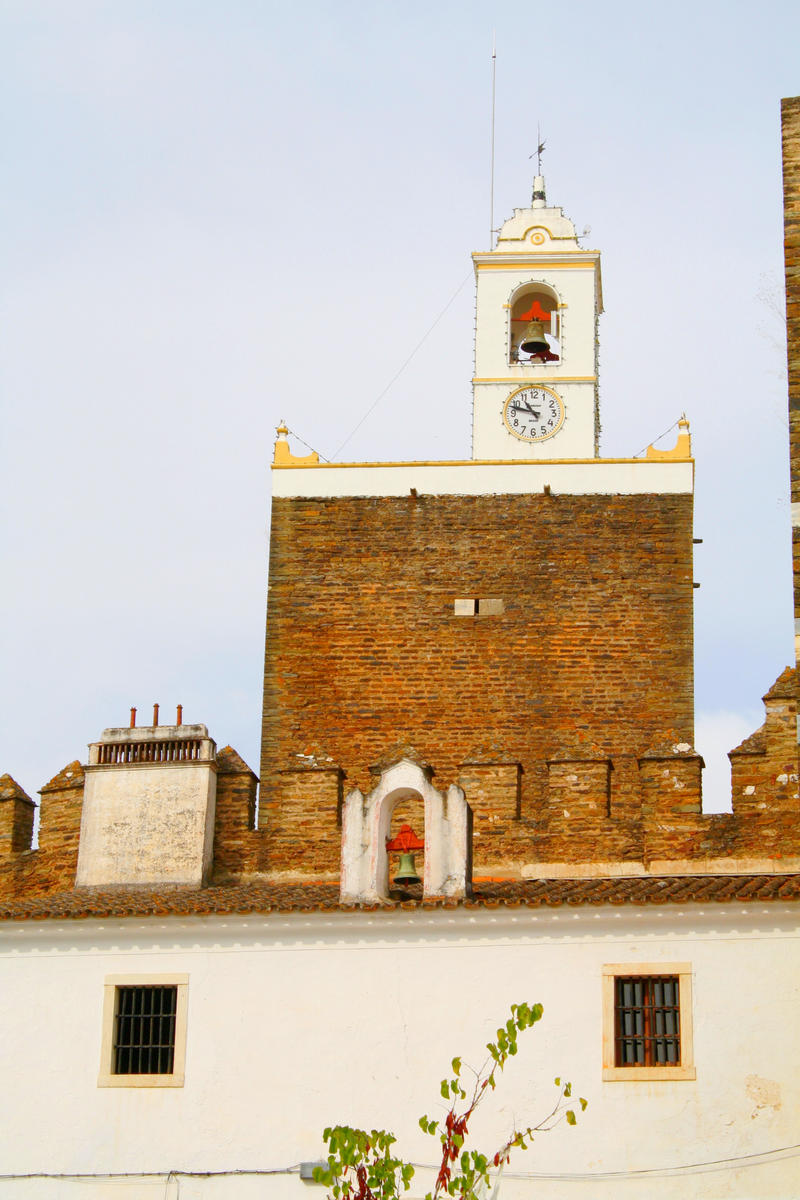Deviation Actions
Description
© Filipinha - All rights reserved
Alandroal Clock Tower I . Inside the Castle
Alandroal Castle
Alandroal Bell Tower . Inside the Castle
Alandroal Bell Tower II . Inside the Castle
Alandroal Old House . Inside the Castle
Alandroal Old House II . Inside the Castle
Alandroal Old House III . Inside the Castle
O Alandroal foi fundado em 1298 por D. Lourenço Afonso, Mestre de Avis, e elevado à categoria de vila em 1486, por uma Carta de Foral atribuída por D. João II.
Ao concelho do Alandroal foram anexados, no século XIX, os territórios dos antigos municípios de Terena :thumb274248802: e Juromenha :thumb261336745: .
A povoação de Vila Real (Villareal), aldeia ribeirinha do Alqueva pertencente a Olivença (sob administração de Espanha) era uma povoação do antigo concelho de Juromenha.
O nome de Alandroal deve-se a neste concelho crescerem aloendros, cuja madeira é usada no artesanato local. Salientam-se ainda os trabalhos feitos em cortiça, pele e chifre.
O castelo medieval foi erguido sob o reinado de D. Dinis (1279-1325), de acordo com a inscrição epigráfica sobre uma das portas, a sua primeira pedra foi lançada em 6 de Fevereiro de 1294 por D. Lourenço Afonso, Mestre da Ordem de Avis. Uma segunda inscrição, no alçado Oeste da Torre de Menagem (hoje integrado na Sala do Tesouro da Igreja Matriz), informa a conclusão de sua edificação, em 24 de Fevereiro de 1298, tambem por D. Lourenço Afonso. Uma terceira inscrição, no torreão à direita do portão principal, datada críticamente entre 1294 e 1298, refere o nome do seu construtor, que se identificou apenas como "Eu, Mouro Galvo".
Em estilo gótico, o castelo apresenta planta oval (na qual se inscreve um pequeno bairro intra-muros), reforçada por três torres de planta quadrangular, nos ângulos, e uma sólida Torre de Menagem adossada à cerca. O portão principal (Porta Legal) é ladeado por duas torres quadrangulares, ligeiramente avançadas (para permitir o tiro vertical sobre a entrada), ligados por uma cortina e encimadas por ameias de remate piramidal.
A Torre de Menagem, de planta quadrangular, divide-se internamente em três pavimentos. O acesso ao seu interior encontra-se, atualmente, entaipado. A esta torre, adossou-se, ainda no século XIII, a Igreja de Nossa Senhora da Graça, que alterada posteriormente, hoje apresenta traços renascentistas, patentes particularmente na abóbada artesoada. Em 1744, o terraço da Igreja foi aproveitado para edificar a Torre do Relógio.
Do século XVII aos nossos dias
Em 1606, a maior parte das construções no interior da muralha encontravam-se arruinadas. No século XVIII, o conjunto perdeu a sua barbacã (muro anteposto às muralhas, de menor altura do que estas, com a função de defesa do fosso de uma fortificação, onde era oferecida a primeira resistência ao agressor), demolida para dar lugar, no interior dos muros, às edificações dos novos Paços do Concelho e da Cadeia da Comarca.
Considerado como Monumento Nacional por Decreto de 16 de Junho de 1910..pt.wikipedia.org/wiki/Castelo_…
Locais a visitar
O Castelo
Torre de Menagem
Igreja Matriz
Igreja da Misericórdia (em Terena)
Fortaleza de Juromenha (em Juromenha)
Barragem de Lucefecit (a oeste de Terena)
Rocha da Mina (em Terena)
www.roteirodoalqueva.com/local…
-------------------------------------------------------------------------------------------------------------------------------------------------------------------------------------------------------
The Alandroal was founded in 1298 by D. Lawrence Afonso, Master of Avis and elevated to a town in 1486, by a charter granted by Foral D. John II.
When the county Alandroal were annexed in the nineteenth century, the territories of the former municipalities of Terena and Juromenha.
The town of Vila Real (Villareal), riverside village belonging to the alqueva Olivenza (under management in Spain) was a town of the former county Juromenha.
The name Alandroal due to oleander flowers grow in this county, whose wood is used in local crafts. Can underline the work done in cork, skin and horn.
The medieval castle was erected under the reign of King Dinis (1279-1325), according to epigraphic inscription on one of the doors, its foundation stone was laid on February 6, 1294 by D. Lawrence Afonso, Master of the Order of Avis. A second inscription, the elevation of the West Watchtower (now integrated in the Treasure Room of the Church), announces the completion of its construction, on February 24, 1298, also by D. Lawrence Afonso. A third inscription in the turret to the right of the main gate, critically dated between 1294 and 1298, refers to the name of its builder, who identified himself only as "I, Moorish Galvo".
Gothic-style castle features oval plan (in which is inscribed a small neighborhood intramural), reinforced by three towers quadrangular, the angles, and a solid Watchtower addorsed to the fence. The main gate (Gate Legal) is flanked by two square towers, slightly advanced (to allow vertical shot on entry), connected by a curtain and topped by battlements shooting pyramid.
The Watchtower, the quadrangular, is divided internally into three floors. Access to your interior is currently entaipado. To this tower, if adossou-even in the thirteenth century, the Church of Our Lady of Grace, which changed later today features Renaissance traits, particularly in patent paneled vault. In 1744, the roof of the church was tapped to build the Clock Tower.
From the seventeenth century to the present day
In 1606, most of the buildings within the walls were ruined. In the eighteenth century, the group lost its barbican (wall prepended to the walls of lesser height than these, with the function of defense of a fortification ditch, where he was offered the first resistance to the aggressor), demolished to make way in inside the walls, the building of the new City Hall and the County Jail.
Considered as a National Monument by Decree of June 16, 1910.






























